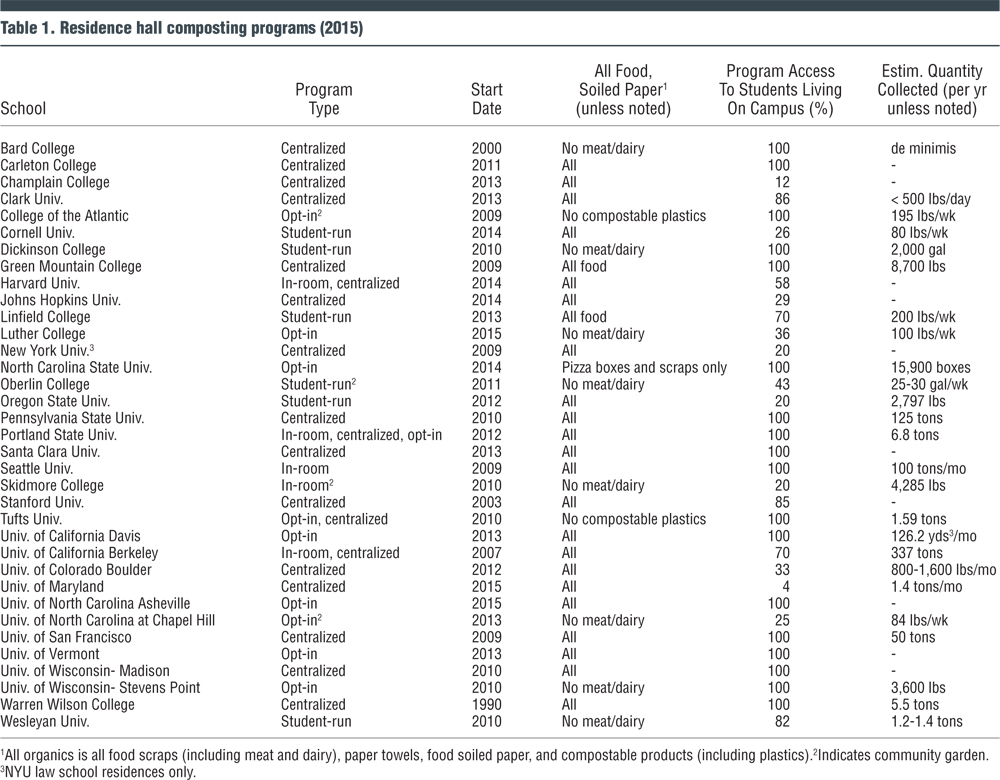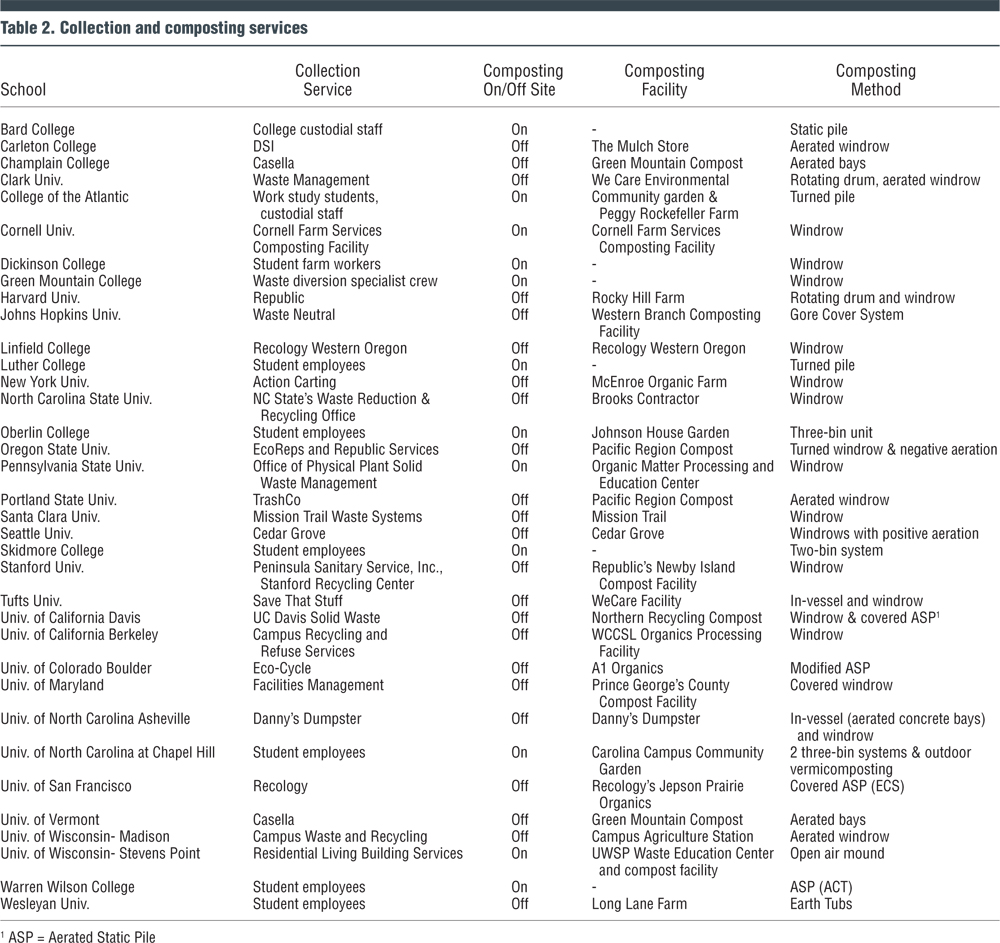Residential hall composting programs have been popping up at universities and colleges throughout the country to help reach campus-wide waste diversion goals.
Claire Siegrist
BioCycle November 2015
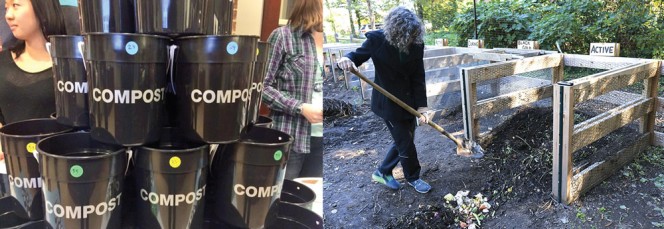
Students at the University of North Carolina (UNC) Asheville who want to divert food scraps are given 2-gallon collection containers (left). At UNC Chapel Hill, vegetative food scraps are collected from residence halls and taken to an on campus community garden where they are composted (right).
At colleges and universities across the United States, residential hall composting programs are becoming more prevalent, especially when following the successful adoption of pre and postconsumer food scraps collection in their dining halls. The higher rate of organics diversion contributes to these universities’ initiatives to achieve Zero Waste, and to encourage environmental stewardship.
The majority of organic waste generated in residence halls comes from take-out food, campus eateries and paper towels from bathrooms. The amount generated depends on a variety of factors including the number of residents with access to the program, size of the school, and emphasis on community engagement. Of the programs implemented in residence halls, some universities have chosen to integrate organics collection as part of the buildings’ infrastructure, while others require volunteers to collect and drop-off their organic materials.
Organics diversion programs at residence halls described in this article are divided into the following categories:
Opt-In: Covers a broad range of programs where students who are interested in composting in their dorms have to go to another location other than their dorm floor to drop off their organics. A subset of opt-in programs are student-run, where student volunteers and/or work study students run the programs and take the organics from a collection point of their choosing in the dorm (e.g., the kitchen) to a more centralized location, either in the dorm or elsewhere on the campus.
Collection for Community Gardens: Organics diverted from the dorm are composted in an on-campus community garden. These may be opt-in programs that are student run.
In-Room and Centralized: Program is integrated into larger campus organics collection service. Students can opt in to participate, and sometimes are given collection containers for their dorm rooms.
Several other approaches are described in the last section of this article. Table 1 summarizes general information about 35 residence hall programs. Table 2 reports on the collection and composting services.
Student Volunteer And Opt-In Programs
Opt-in programs require less effort from school administrators and custodial staff. The success of the program relies mainly on students who manage the logistics and student outreach. At Cornell University in Ithaca, New York, approximately 10 freshman volunteers, some new to composting themselves, act as point people for their kitchen’s 2-gallon organics collection bin. These students are responsible for taking the full bin, as needed, to a location near their dorm, where Farm Services collects the material and delivers it to the university’s on-site composting facility. Each week, about 80 lbs of organics are collected from five freshman dorms.
Volunteers provide compost education to their “hallmates” to help limit contamination. “Cornell’s goal is to develop a strong program that not only diverts waste from the landfill, but is also educational, community building, and helps ensure safe and healthy compost collection,” explains Spring Buck, Associate Director of Facilities Management. The university focuses on first-year students in hopes that they will continue to separate organics correctly throughout their time at Cornell and beyond. Upperclassmen houses have their own dining halls where Cornell Dining staff diverts postconsumer organics.
Oregon State, Wesleyan, Dickinson, Linfield and Luther colleges and universities utilize a similar volunteer approach where student volunteers or employees manage collection in their residence halls by removing and cleaning bins and educating their peers.
University of Vermont (UVM) Recycling offers 12-inch by 7-inch by 4-inch Bag to Earth brown paper collection bags for students who opt into its program. Once filled, students deposit the bags into a 13-gallon, compostable plastic lined container at the front desk of their residence hall complex. Each Tuesday and Friday, two work-study students take the full containers from the 15 residence hall complexes to the main collection area, a temperature controlled walk-in cooler in UVM’s main student center. Casella Organics picks up the material and delivers it to Green Mountain Compost in nearby Williston. UVM’s Eco Reps promote the program and educate students about acceptable materials through in-dorm posters, bulletin boards and peer-to-peer education tables in hall lobbies.
The University of North Carolina (UNC) Asheville utilizes a similar approach. Students wanting to participate are given their own 2-gallon collection container, but some students choose to use their own collection containers. The Student Environmental Center has distributed about 80 collection bins to students, who put their organics into an indoor central compostables receptacle, which is collected by paid student Eco Reps and emptied into an outdoor tote for pick-up. Eco Reps also inform students about organic waste collection.
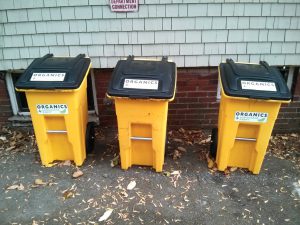
At Tufts University, students living on or off campus can deposit their organics in outdoor collection totes.
Tufts University has a similar program, where students living on or off campus can deposit their organics in outdoor collection totes. The 2,527 students living in residential advisor (RA)-run residence halls also have collection containers in their kitchens, which are then emptied into the collection totes by Eco Reps.
Collection For Campus Community Gardens
Oberlin College, University of North Carolina (UNC) at Chapel Hill and the College of the Atlantic (COA) utilize similar volunteer programs but haul their organics to on-campus community gardens where finished compost is used to grow fruits and vegetables.
Eight student employees who form the Resource Conservation Team (RCT) run the program at Oberlin, a small college in northern Ohio. Each year, the RCT selects about 14 volunteer Compost Captains to facilitate collection programs in their halls. Compost Captains place 5-gallon organics collection buckets in a central location in the dorms, typically their floor’s kitchen or lobby, and educate hallmates about the program and accepted organic materials. Meat, dairy and compostable products are not accepted although a certain amount still are found in the buckets. Once weekly, the RCT collects the buckets from the dorms, picks out any visible contaminants, and brings the material to the Johnson House Garden, where bins are emptied, cleaned and returned to the halls to restart the cycle. About 25 to 30 gallons of compostable materials are generated in the residence halls and delivered to the garden each week.
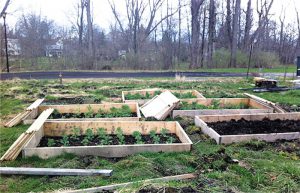
Compost Captains at Oberlin College place 5-gallon organics collection buckets in a central location in the dorms. Organics are collected once a week and taken to the Johnson House Garden (above) to be composted and used in the garden as soil amendment.
The RCT manages a “3-stall” composting system — essentially three bays divided by concrete construction barriers — with materials moved from bin to bin, using pitchforks and shovels. The Grounds Service Manager mechanically turns the pile with a Bobcat as needed, usually twice a semester. In three to ten months, depending on the season, compost is available to apply to the garden. Each season from March until October, students grow a variety of vegetables, such as tomatoes, basil, squash, broccoli, and cucumbers. Produce is sold to student dining halls and cooperative houses on campus. Proceeds from these sales help fund the RCT.
UNC Chapel Hill’s residential hall composting program is completely voluntary. UNC’s Office of Waste Reduction and Recycling (OWRR) offers 87-ounce airtight collection bins at eight residence halls. In the 2014-2015 academic year, 212 students checked out these bins. Students who opt in empty their vegetative food scraps in a 32-gallon outdoor community collection cart. Once a week, OWRR takes the food scraps to the Carolina Campus Community Garden (CCCG), where student and employee volunteers turn the food waste into compost. All of the produce harvested at CCCG is donated to the UNC housekeepers for their personal use.
COA provides 5-gallon bins in all residence hall kitchens. Students who opt into this program bring their organics to the drop-off location by the community garden once or twice per week. Two to six work-study students manage composting at the garden, and are also responsible for the program’s research, planning, documentation, outreach and follow up.
Skidmore College offers a collection program in its two on-campus apartment villages. Each of the 218 apartments has a small bin lined with a paper Bag To Earth bag. Apartment residents are asked to place the bags in a large Rubbermaid tub outside of the laundry room for collection. Student employees take the organics to the campus community garden and manage the composting piles.
In-Room And Centralized Composting Programs
Other universities have similar opt in programs that require less effort from residents and more by the university by integrating organics collection into residence hall infrastructure. Although students are still responsible for bringing their own organics to a centralized location, having custodial staff service the bins eliminates the need to find student volunteers or employees willing to do the job. Having custodial staff empty bins allows for more residential halls to participate in organics collection programs.
Seattle University provides a collection bin — which varies in size from 1.2 gallons to 7 gallons depending on the number of students in the living space — along with trash and recycling bins in all of the 1,000 residence hall rooms on campus. Seattle University estimates that about 80 percent of students living in these rooms use their collection bins daily. Students are responsible for bringing their organics to the recycling room on their floor, where custodial staff collect and take them to a centralized location for Cedar Grove Composting to pick up. As for education, the college’s Recycling Coordinator trains RAs and Orientation Assistants at the start of the year and provides flyers in students’ mailboxes to describe materials that can be placed in the “compost bin.”

At the University of California Berkeley, students are given 2-gallon bins (left) to use in their rooms to collect food scraps. These are emptied into centralized bins in the dorms, which then are taken by custodial staff to an outdoor collection area (right).
The University of California (UC) Berkeley, Portland State University, and Harvard University offer both in-room and centralized collection options for students wanting to participate. At UC Berkeley, 70 percent of residence halls have centralized or in-room organics collection built into the infrastructure, and approximately 5,450 students and live-in staff actively participate in the program. Residents utilizing the in-room organics collection program empty their full 2-gallon bins at a centralized 6-gallon EcoSafe EcoCaddy in the building. Custodial staff transports the bins in restrooms and kitchens to the outdoor collection area. To minimize contamination, UC Berkeley provides standardized signs on all bins and place-specific signs with items commonly thrown away.
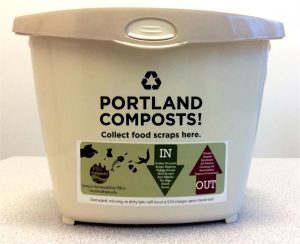
Portland State University provides students with 2-gallon organics pails to use in their rooms, along with recycling and trash containers.
At Portland State, seven out of ten residence halls are equipped with 2-gallon organics pails in each room along with the standard recycling and trash collection bins. One residence hall has 2-gallon pails in the community kitchens. Students in the final two halls can pick up 2-quart lidded yogurt containers from the cafeteria to take to their rooms and return to the cafeteria when filled, where dining staff empty the containers into organics collection totes and clean them for reuse. Each fall, the Campus Sustainability Office sets up a table to interact with students and trains RAs about composting and sustainability. Contamination is typically not an issue in its program. Portland State has made a huge effort to educate students about organics collection options in residences and has gone above and beyond to make organics collection accessible for students.
Like Cornell, Harvard University offers a dorm-room collection program solely to freshmen mainly because upperclassmen houses have composting in the in-house dining halls. All 600 suites in the 17 freshman dorms have a 2.4-gallon Exaco organics collection bin, which gives all 1,640 freshmen access to the program. Each freshman dorm kitchen also contains a 23-gallon Rubbermaid Slim Jim organics recycling container. Students must take their organics to a centralized waste collection room and empty their 2.4 gallon bin into a ClearStream CompostMax collection container. Harvard also provides small BioBags for students to line their bins and compostable gloves for bin cleaning. The custodial crew takes the bags from the waste collection rooms and kitchens outside of the building for Republic to collect.
Although Santa Clara University (SCU), Clark University, Stanford University and University of Wisconsin Stevens Point (UWSP) do not provide bins for each room, they offer small collection receptacles for interested students upon request, so students can collect organics in their rooms and deposit them in a centralized location in their dorms for custodial staff to service. SCU’s Center for Sustainability and the Housing Office has a free, school year “rental” organics pail program (with 129 current renters) and 10-liter BioBag liners for interested students. UWSP offers free 2-gallon MaxAir compostable buckets from BioBag to interested students.
Dining Services at Clark University provides free, lidded yogurt containers that are distributed to students by volunteers. Two-gallon lidded bins are located in all dorm kitchens, which are hand-sorted to eliminate contaminants, emptied into 30-gallon bins, and rinsed by the Clark student Recycling Crew daily. Every morning, building custodians empty the 30-gallon bins, lined with noncompostable plastic bags. Organics are sent to WeCare Organics’ composting facility, which is able to screen out remaining contaminants, including the collection bin liners. Students living off-campus can bring their food scraps to the student-run Community Garden, where the Herban Gardeners manage a two-bin hand-turned composting system. Finished compost is used in the Community Garden.
At Stanford University, students are introduced to composting during new student orientation through a sustainable living guide and video. Stanford’s 10,900 students have access to organics collection in 3,132 personal kitchens in apartments and 32 commercial kitchens in undergraduate houses, which equates to about 85 percent of campus residences. Two-gallon organics collection bins are offered free-of-charge to graduate students, and undergraduate students and live-in staff can purchase a bin for $9 at the campus bookstore. Not many students purchase these bins because most organic waste is generated in the dining halls and bathrooms, rather than individual rooms. In dorm bathrooms and shared kitchens, custodial staff is responsible for collecting the organics. “All community collection bins are well labeled to discourage contamination… If we see ongoing contamination the residence will receive an email notifying them of the problem,” explains Kristin Parineh, Manager of Housing Sustainability and Conservation Programs.
In eight residence halls at the University of Colorado (UC) Boulder, a covered 23-gallon organics collection bin, marked by posters as well as a shadow box, is located at each halls’ community center staffed desks. To get their pilot program up and running, UC Boulder focuses on outreach, education and faculty and staff engagement to ensure that the program is utilized. Student staff members working at the desk are available 24/7 to promote the program and answer questions. In some halls, students can check out 5- to 10-gallon buckets to use in their community kitchen that can then be emptied into the primary bin when full. Organics collection has also been integrated into residential hall events, which helps increase student participation and volume. For these events, a 30-gallon ClearStream folding frame container is used to collect organics. Most education and outreach comes from student leadership and hall staff through games like “compost jeopardy” where students are shown a presentation and then play a quiz game, providing an opportunity to compete based on their understanding of the composting program.
Unlike these universities, others have integrated programs that require students to provide their own individual collection containers. Carleton College’s custodial staff collects organic waste in residential bathrooms and common areas. Students who wish to divert food scraps and other organics must provide their own in-room collection container. Carleton’s sustainability office uses data collected by student waste monitors, who track and record contaminants in the waste stream, to target challenges on specific floors through floor meetings and floor-specific charts noting common contaminants. Although all organics are accepted, mostly paper towels and compostable take-out containers are collected from residence halls. Because all students living on-campus have a meal plan, students can properly divert their organics in the dining halls. The University of San Francisco and UC offer residential paper towel collection bins for composting as well.
Custodians at the University of Maryland (UMD) service organics collection bins in student lounges, hallways, a multipurpose room and restrooms. At the beginning of each semester, Resident Life holds discussions about waste separation and the organics collection program during initial floor meetings; a brochure is given to students upon move-in. They have also appointed “compost champions” who monitor bins and answer any questions from their peers. Contamination is not a huge problem, but there are some items such as hot pocket wrappers and feminine products that confuse students. Once these problematic contaminants are identified, Resident Life further educates the residents, mainly through additional signage.
Pennsylvania State University houses roughly 13,000 students on campus; about 10 percent participate in the residential hall organics collection program. In the campus’s 53 residence halls, 35-gallon organics collection bins are located on 88 percent of the 359 occupied floors. Two-gallon collection containers are available for individual use upon request. Minor contamination is screened out at Penn State’s on-campus composting center, while grossly contaminated collection bags are sent to the landfill. Specific intervention in specific locations is used if the issue is recurring.
Residence halls at Green Mountain College, Johns Hopkins University, Champlain College, Bard College, New York University Law School, University of Wisconsin Madison, and Warren Wilson College also are equipped with 3-bin sorting centers, divided into organics, recyclables and trash. These are emptied by custodial staff.
Additional Programs And Pilots
Universities with existing infrastructure for organics collection in dining halls, such as Colorado State University, promote diverting residence hall food scraps at university dining centers. Colorado State offers public access composting in three of the five Dining Centers. Ohio University offers a similar option. North Carolina State University has strategically located dumpsters around the campus solely for pizza box composting. These dumpsters are colorful and depict a pizza pie in order to differentiate them from standard trash or recycling dumpsters. When contamination occurs, the pizza box dumpster’s location is reevaluated, additional temporary signage is provided at the sorting site, and emails are sent to the Residence Directors.
Green Mountain College (GMC) and Harvard tested out vermicomposting programs before switching to their current programs. Before last year, GMC offered vermicompost bins and red wigglers to students interested in collecting food scraps in the dorms. Most volunteers didn’t pay adequate attention to the worm bins, and red wigglers either died or the bins started to emit unpleasant odors. Between 2011 and 2013, Harvard offered a vermicomposting program in one freshman dorm which was maintained by three students. This program was discontinued when the students graduated. Maintaining vermicompost bins over breaks was difficult.
One takeaway from this survey of residence hall organics diversion programs is to “just start,” as noted by Lisa Bjerke, a Masters student at the College of the Atlantic. “Start small but include everything organic and grow slowly,” she adds. “Get everyone on board and institutionalize the program.”
Claire Siegrist, a recent graduate of Cornell University with a BS in Natural Resources Policy and Management, is a Contributing Writer to BioCycle.
